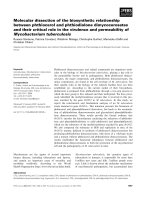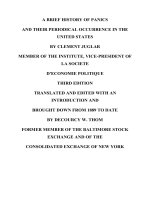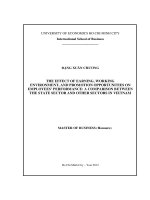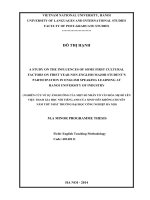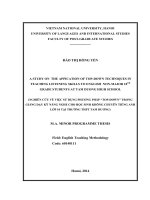Meanings of english prepositions over, above, under and below and their equivalent expressions in vietnamese a study in the light of principled polysemy
Bạn đang xem bản rút gọn của tài liệu. Xem và tải ngay bản đầy đủ của tài liệu tại đây (1 MB, 90 trang )
VIETNAM NATIONAL UNIVERSITY, HANOI
UNIVERSITY OF LANGUAGES AND INTERNATIONAL STUDIES
FACULTY OF POST GRADUATE STUDIES
ĐỖ TUẤN LONG
MEANINGS OF ENGLISH PREPOSITIONS “OVER, ABOVE, UNDER,
AND BELOW” AND THEIR EQUIVALENT EXPRESSIONS IN
VIETNAMESE: A STUDY IN THE LIGHT OF PRINCIPLED
POLYSEMY
NGỮ NGHĨA GIỚI TỪ TIẾNG ANH “OVER, UNDER, ABOVE,
BELOW” VÀ PHƯƠNG TIỆN BIỂU ĐẠT TƯƠNG ĐƯƠNG
TRONG TIẾNG VIỆT
M.A Major Thesis
Major: English Linguistics
Code: 60220201
HA NOI – 2016
iii
VIETNAM NATIONAL UNIVERSITY, HANOI
UNIVERSITY OF LANGUAGES AND INTERNATIONAL STUDIES
FACULTY OF POST GRADUATE STUDIES
ĐỖ TUẤN LONG
MEANINGS OF ENGLISH PREPOSITIONS “OVER, ABOVE, UNDER
AND BELOW” AND THEIR EQUIVALENT EXPRESSIONS IN
VIETNAMESE: A STUDY IN THE LIGHT OF PRINCIPLED
POLYSEMY
NGỮ NGHĨA GIỚI TỪ TIẾNG ANH “OVER, UNDER, ABOVE,
BELOW” VÀ PHƯƠNG TIỆN BIỂU ĐẠT TƯƠNG ĐƯƠNG
TRONG TIẾNG VIỆT
M.A Major Thesis
Major: English Linguistics
Code: 60220201
Thesis Advisor: Assoc. Prof. Dr. LÂM QUANG ĐÔNG
HA NOI – 2016
iv
DECLARATION
I declare that this MA thesis, entitled Meanings of English prepositions “over,
above, under and below” and their equivalent expressions in Vietnamese: A study
in the light of Principled Polysemy, is entirely the result of my own work. The
thesis contains no material which has been accepted for the award of any other
degree or diploma in any university or tertiary institution, and to the best of my
knowledge, neither does it contain material previously published or written by
another person, except where due acknowledgement is made in the text.
Signature
Đỗ Tuấn Long
v
ABSTRACT
Meanings of English prepositions over, above, under and below and their
equivalent expressions in Vietnamese: A study in the light of Principled
Polysemy
Linguists have known that prepositions, especially spatial markers, develop
their meanings in semantic networks in which the prototypical meaning is the
core from which other extended senses develop. One framework offering such
kind of semantic network is Principled Polysemy introduced by Tyler and Evans
in 2003. This study focuses on providing additional information for the meanings
of the four English prepositions over, above, under, below beside works presented
by Tyler and Evans. Comparative and contrastive methods were exploited to
analyze data from three sources namely “Gone with the Wind”, “Vanity Fair” and
721 articles of contemporary topics on BBC and CNN. The results show that over
has two online meanings, under possesses one meaning not analyzed by two
framework founders. Particularly, over in certain cases means because of (reason)
and by (a means to do something), under is used to denote a situation or state that
someone or something is experiencing. Additionally, graphic illustrations for
extended senses of three prepositions above, under, below were added, which
facilitates learners to better construe the semantics of the prepositions. The
Vietnamese equivalents for those prepositions are presented systematically in the
order of their appearances in the semantic networks, which makes learners‟
reference to those spatial markers more conveniently.
vi
ACKNOWLEGEMENTS
First and foremost, I would like to express my deepest gratitude to my supervisor,
Assoc.Prof.Dr Lâm Quang Đông for transferring me his specialized knowledge,
his inspiring me the love in linguistics as well as his valuable suggestions, advice
and correction during my the thesis throughout.
I also take this opportunity to thank all my lecturers in the Department of
Graduate Studies at University of Languages and International Studies, Vietnam
National University, Hanoi for many of their interesting lectures, which have
surely contributed to the foundation of my thesis.
Finally, I would like to show my deep gratitude to my family, especially my wife
for her support, encouragement and understanding, without which my theis would
not have been accomplished.
Hanoi, November 2016
Do Tuan Long
vii
TABLE OF CONTENTS
LIST OF ABBREVIATIONS
LIST OF TABLES
LIST OF FIGURES
PART A: INTRODUCTION
1. Rationale of the study
1
2. Objectives of the study
3. Research questions
3
3
4. Structure of the thesis
3
PART B: DEVELOPMENT
Chapter 1: LITERATURE REVIEW & THEORETICAL BACKGROUND
1.1. Literature Review
5
1.1.1. Full-specification Approach
5
1.1.2. Principled Polysemy Framework
8
1.2. Theoretical Background
12
1.2.1. Important tenets of Principled Polysemy Framework in the light of
cognitive linguistics
12
1.2.2. Principles of contrasting English and Vietnamese
1.2.3. Principles of semantic extension from spatial to non-spatial
1.3. Chapter summary
17
18
20
CHAPTER 2: RESEARCH METHODOLOGY
2.1. Data description
2.2. Research methods
21
22
CHAPTER 3: FINDINGS AND DISCUSSION
3.1. Research question 1
3.1.1. New findings for the meanings of over
3.1.2. New findings for the meanings of under
25
25
31
3.2. Research question 2
32
viii
3.2.1. Graphic illustrations for extended senses of above
32
3.2.2. Graphic illustrations for extended senses of under
38
3.2.3. Graphic illustrations for extended senses of below
43
3.3. Research question 3
3.3.1. Potential Vietnamese equivalents of over
3.3.2 Potential Vietnamese equivalents of above
3.3.3. Vietnamese equivalents of under
3.3.4. Vietnamese equivalents of below
3.4. Chapter summary
48
49
58
60
65
67
PART C: CONCLUSION
1. Recapitulation
2. Challenges and limitations
3. Orientations to further research
68
68
69
REFERENCES
APPENDIX
71
76
ix
List of Abbreviations
CA
Contrastive Analysis
CL
Cognitive Linguistics
IELTS:
International English Language Testing System, co-owned by
University of Cambridge ESOL, British Council and IDP
Education.
L2
Second language
LM:
Landmark
ESL
English second language learners
TR:
Trajector
ULIS-VNU:
University of Languages and International Studies,
Vietnam National University, Hanoi
x
List of tables
Table 1.1: Schemas proposed by Lakoff (1987) for over besides the central
schema
Table 1.2: Analysis of “British Ambassador in hot water over joke”
Table 3.1: Paraphrases of (3.1) and (3.2)
Table 3.2: Summarized information of over
Table 3.3: Summarized information of above
Table 3.4: Summarized information of under
Table 3.5: Summarized information of below
xi
List of figures
Figure 1.1: Central image schema
Figure 1.2: The semantic network for over
Figure 1.3: The semantic network for under
Figure 1.4: The Rubin‟s vase
Figure 1.5: The proto-scene of over
Figure 3.1: The semantic network for above
Figure 3.2: The More Sense of above
Figure 3.3: The Superior Sense of above
Figure 3.4: The Next-one-up Sense of above
Figure 3.5: The Topographical-distance Sense of above
Figure 3.6: The Less Sense of under
Figure 3.7: The Control Sense of under
Figure 3.8: The Covering Sense of under
Figure 3.9: The Non-Existence Sense of under
Figure 3.10: Semantic network for below
Figure 3.11: The accurate semantic network for below
Figure 3.12: The Less Sense of below
Figure 3.13: The Inferior Sense of below
Figure 3.14: The Next-one-down Sense of below
Figure 3.15: The Topographical-distance Sense of below
xii
PART A: INTRODUCTION
1. Rationale of the study
English prepositions are not easy for learners to acquire, and this is an obstacle
for those who want to learn English successfully. Perhaps, one reason is that it is
difficult to characterize the semantics of prepositions. Take the two following
sentences as an example (Tyler and Evans, 2003:65)
(1.1) The picture is over the mantle.
(1.2) The picture is above the mantle.
In fact, both sentences denote a configuration in which the Trajector (TR - the
picture) is higher than the Landmark (LM - the mantle), and it is impossible to
decide if there is a contact between the LM and the TR. However, another
example posed by Tyler and Evans (2003) indicates something different. The
sentence (1.3) “Mary hung her jacket over the back of the chair.” is interpreted
differently from the sentence (1.4) “Mary hung her jacket above the back of the
chair”. It is universally known that when humans put a cloth or anything else on
the back of the chair, that thing should be higher and in contact with the back of
the chair. In the sentence (1.3), the preposition over denotes what humans often
perceptualize, the jacket is higher and in contact with the back of the chair. Yet,
the meaning of sentence (1.4) is different; the jacket is higher and in no contact
with the back of the chair.
Furthermore, prepositions tend to develop a complex set of extended meanings,
for example, under has developed at least 9 meanings 1, many of which do not
appear to be systematically related. Tyler et al (2011) reviewed that although
linguists have long been aware that prepositions develop complex polysemy
networks, the meaning networks surrounding spatial markers (and the systematic
processes of meaning extension from which they result) have only become the
1
Oxford Dictionary (8th Edition, Cambridge University Press)
1
foci of linguistic inquiry in the last 20 years. The best descriptive grammars and
dictionaries present the multiple meanings of prepositions as largely arbitrary.
Three traditional linguists (Bloomfield, 1933; Frank, 1972; Chomsky, 1995)
represented the semantics of English prepositions as arbitrary. As a result,
memorization has been often suggested as the best strategy. However cognitive
linguistics (CL) offers an alternative perspective, suggesting that the many
distinct meanings associated with a particular preposition are related in
systematic, principled ways (e.g., Brugman, 1988; Dewell, 1994; Dirven, 1993;
Lakoff, 1987; Linder, 1982; Hawkins, 1988; Herskovits, 1986, 1988; Vandeloise,
1991, 1994).
In fact, after criticizing previous approaches to the semantics of English
prepositions (i.e. monosemy and homonymy) and Lakoff‟s account to over, Tyler
and Evans developed Principled Polysemy framework, which was described to
fill the gaps that other scholars leave.
Though the framework could explain clearly and (for the most part) convincingly
how new meanings developed from established ones on the basis of experiential
correlations, three weak points of the framework still exist. First, local and online
construction of meaning (e.g. over and under’s) was not fully analyzed as stated
by Tyler and Evans. Additionally, graphic illustrations for extended senses of the
other prepositions were not provided, which to some extent makes it difficult for
readers to construe the semantic extension from spatial to non-spatial. Last but
not least, Thora (2004) pointed out that the research results introduced by Tyler
and Evans (2003) were somewhat vague as they claimed to use their native sense
of language to investigate English prepositions‟ semantics. Scopus linguistics was
not in use to collect data; hence, it needs revising to confirm the results.
The context discussed above inspired me to conduct a study for my M.A thesis
entitled Meanings of English prepositions "over, above, under and below" and
2
their equivalent expressions in Vietnamese: A study in the light of Principled
Polysemy.
2. Objectives of the study
As mentioned in the previous part, this thesis aims at filling out the gaps that
Tyler and Evans left in analyzing the semantics of the four prepositions. First, we
wish to find out the local and online construction meaning of over and under in
the light of Principled Polysemy beside works done by Tyler and Evans. In
addition, basing on the analysis of the data collected with reference to the
theoretical framework Principled Polysemy, we will provide graphic illustrations
for extended senses of above, under and below. The third objective is to discover
potential Vietnamese equivalents for those spatial particles, which to some extent
may facilitate the acquisition of those spatial languages. Those objectives are
realized via the following research questions.
3. Research questions
This study is conducted to provide answers to three research questions:
1. What are the new findings for the meanings of the four prepositions
besides those presented by Tyler and Evans in the light of Principled
Polysemy?
2. What are graphic illustrations for each extended sense of the four
prepositions in the light of Principled Polysemy?
3. What are potential Vietnamese equivalents of those prepositions?
4. Structure of the thesis
The thesis consists of three main parts. In the first part - Introduction – the
rationale, objectives of the thesis and three research questions are presented. The
second part is Thesis Development which consists of three chapters: (1)
Literature Review and Theoretical Background, (2) Research Methodology and
3
(3) Findings and Discussion. In the first part, I will carry out a literature review
on different approaches to the semantics of English prepositions and then provide
theoretical background for the study. The second part presents the methods to
conduct the study and then research results will be presented in the third chapter.
The last part is Conclusion in which I summarize the research results and point
out the research‟s limitations and orientations to further study.
4
PART B: DEVELOPMENT
Chapter 1: LITERATURE REVIEW & THEORETICAL BACKGROUND
In this part, I will first conduct a literature review on different approaches (i.e.
Full-specification and Principled Polysemy) to the semantics of English
prepositions, and then analyze the theoretical background for my research study.
1.1. Literature Review
Bloomfield, Frank and Chomsky advocated different ways to construe spatial
markers in English. However, what the three authors supported is different from
that advocated by cognitive linguists. Numerous studies (Brugman and Lakoff
(1988); Dewell (1994); Coventry and Garrod (2004); Herskovits (1986); Kreitzer
(1997); Lindner (1981); Lindstromberg (1997); Sinha and Kuteva (1995), Tran
Quang Hai (2001)) have been conducted more or less in light of Lakoff‟s theory,
so it is appropriate to review his approach to the semantics of English
prepositions. Tran Quang Hai (2001) compared and contrasted the semantics and
pragmatics of locative prepositions in both English and Vietnamese to find out
the similarities and differences. In this study, only prototypical meanings of
locative prepositions were analyzed, extended senses were neglected.
1.1.1. Full-specification Approach
Lakoff took over as a case study in English prepositions and his analysis is
sometimes described as the full-specification approach to lexical semantics. The
core point in his theory is that the senses associated with prepositions like over,
which are grounded in spatial experience, are structured in terms of imageschemas. Lakoff supposed that an image schema combining elements of both
ABOVE and ACROSS prototypical sense of over. The distinct senses associated
with over are structured with respect to this image - schema which provides the
category with its prototype structure. In sum, Lakoff claims that the schemas
5
which are different from the central schema are considered to represent distinct
senses associated with over. According to this model of word meaning, the
central schema for over has at least six distinct and closely related variants (see
Figure 1.1), each of which is stored in semantic memory.
Figure 1.1: Central image schema (adopted from Lakoff, 1987:423)
Given the range of senses over is associated with in addition to the ABOVEACROSS sense (summarised in Table 1.1), this model results in a potentially vast
proliferation of senses for each lexical item.
Table 1.1 Schemas proposed by Lakoff (1987) for over besides the central
schema
6
According to Lakoff, over has, at the very least, several dozen distinct senses.
Although the number of senses is not problematic per se, the absence of clear
methodological principles for establishing the distinct senses is problematic.
There are two main problems: (1) a failure to distinguish between polysemy and
vagueness, and (2) unconstrained methodology. Tyler and Evans indicated that
Lakoff denied the role of context in meaning altogether. Particularly, Tyler and
Evans (2003) argue that the examples in (1) do not represent distinct senses of
over (one specifying contact and one specifying lack of contact):
1a. The bird flew over the wall.
b. Sam climbed over the wall.
Instead, Tyler and Evans suppose that the interpretation of over with respect to
contact or lack of contact derives from the integration of over with the other
elements in the sentence. Our knowledge about birds (they can fly) and people
(they cannot), provides us with the inference that birds do not come into contact
with walls when crossing over them while people do. In other words, the
linguistic context together with encyclopedic knowledge provides the details
relating to the presence or absence of contact. According to Tyler and Evans, over
here is vague with respect to contact. Tyler and Evans argue that while Lakoff‟s
position on polysemy as a conceptual phenomenon is correct, it is also important
to take into account the crucial role of context in word meaning.
Lakoff‟s approach has also been blamed on a lack of methodological
constraints. In other words, Lakoff provides no principled criteria for determining
what counts as a distinct sense. This means that the polysemy account presented
for over (or whatever lexical item we might apply the approach to) results purely
from the intuitions (and perhaps also the imagination) of the analyst rather than
actually representing the way a particular category is represented in the mind of
the language user. This problem has been discussed in some detail by Sandra and
Rice (1995) and by Sandra (1998) [cited in Evans, 2006:342]
7
1.1.2. Principled Polysemy Framework
The framework Principled Polysemy first introduced in the book "The
Semantics of English Prepositions" in 2003 is used to analyze the meanings of
certain English prepositions and present them in semantic networks.
In fact, the framework is built upon works by Lakoff and Claudia Brugman and
as part of cognitive lexical semantics; it is based on the following premises or
assumptions (cited in Evans, 2006):
(1) Words and their senses represent conceptual categories, which have much in
common with non-linguistic conceptual categories. It follows that linguistic
categories have prototype structure.
(2) Word meanings are typically polysemous, being structured with respect to a
central prototype (or prototypes). Lexical categories therefore form radial
categories which can be modelled as a radiating lattice structure.
(3) Radial categories, particularly meaning extensions from the prototype, are
motivated by general cognitive mechanisms including metaphor and image
schema transformation.
(4) The senses that constitute radial categories are stored rather than generated.
By analyzing the semantics of English prepositions, Tyler and Evans mean that
a preposition (or a word) has prototypical meaning and then from this meaning
other extensions occur. So, it is necessary first to identify the prototypical
meaning of a preposition and present other meaning extensions in a semantic
network for that preposition. According to Tyler and Evans, prototypical meaning
of a word needs to have four following characteristics: (1) earliest attested
meaning; (2) predominance in the semantic network; (3) relations to other
prepositions; and (4) ease of predicting sense extensions.
After finding the prototypical meaning of a preposition, it is crucial to decide
whether a particular sense of a preposition counts as a distinct sense and can
therefore be established as a case of polysemy. Founders of the framework
8
provided two criteria: (1) for a sense to count as distinct, it must involve a
meaning that is not purely spatial in nature, and/or a spatial configuration holding
between the TR and LM that is distinct from the other senses conventionally
associated with that preposition; and (2) there must also be instances of the sense
that are context-independent: instances in which the distinct sense could not be
inferred from another sense and the context in which it occurs.
The framework Principled Polysemy is the fundamental basement in this study
because it could successfully explain
… how new meanings develop from established ones on the basis of
experiential correlations. Accounting for such processes in language
without simply relying on the often too vague concept of "metaphorical
extension" which has frequently been claimed to be responsible for the
usage of similar forms in different domains is a major achievement.
Furthermore, the notion of "contrast set" is very useful in accounting for
the relationships of prepositions to each other, which are often not
sufficiently explained by opposing features. Thus, the basic approach
is both innovative and convincing. (From Thora, T (2004, para. 11).
Review of The Semantics of English Prepositions [Retrieved from
on 20
June 2015]
In the following part, we will present and then comment on works done by
Tyler and Evans. To the best of our knowledge, Tyler and Evans left two gaps in
analyzing the semantics of over, above, under, below in the light of Principled
Polysemy. The first one is the semantic gap in the meanings of over and under.
Tyler and Evans (2003:80) took over as a case study to shed light on the analysis
of other prepositions. They provided a semantic network for over with one central
meaning and fifteen extended meanings.
9
Figure 1.2: The semantic network for Over (Tyler and Evans, 2003:80)
After analyzing data collected, we realize that over in the following sentence
could not be categorized in any of the senses.
1.2. British Ambassador in hot water over joke.
The above example is a headline on BBC, and there is no verb. The complete
sentence, as understood by readers, is “British Ambassador is in hot water over
joke”. We can analyze the structure of the sentence like in the following table.
“Over joke” is treated as something new because it needs analyzing to understand
the meaning of the whole sentence.
10
British Ambassador
is
in hot water
over joke.
Subject
Verb
Adverbial
Something new
Table 1.2: Analysis of “British Ambassador in hot water over joke”
Normally, over may denote a spatial-physical configuration between a LM and
a TR in the above sentence; but in fact there is no such configuration. So in this
case, over denote a non-spatial meaning. In order to understand the non-spatial
meaning of over, we consulted several dictionaries2; however, the answer yields
nothing. The semantic network for over proposed by Tyler and Evans did not give
us any clues to trace the meaning of over in this case.
Additionally, speakers of English may find it familiar to utter sentences like
“We heard it over the radio” (Oxford Dictionary). Over in this case denotes a
means of telecommunication by which the speaker(s) heard about something. The
meaning of over in this case could not be seen via the network of Tyler and
Evans.
Furthermore, we suppose that none of the five senses of under proposed by
Tyler and Evans could be used to explain the meaning of under in the following
sentence from BBC.
1.3. Urban Capital has sold 220 of 250 units currently under construction.
In fact, under construction refers to a state or situation that a sold unit of Urban
Capital is experiencing.
2
Oxford Dictionary Online, Cambridge Dictionary Online, Merriam Webster Dictionary.
11
Figure 1.3: The semantic network for Under (Tyler and Evans, 2003:124)
The second gap is a lack of graphic illustrations for each extended sense of
above, under, below, which may make it harder for readers to construe.
Additionally, the illustration of the semantic network for below is not accurate
because Up cluster cannot be associated with below. The above-mentioned gaps
will be bridged via the answers to research questions in the chapter 3.
1.2. Theoretical Background
This study is conducted in the light of Cognitive Linguistics (CL), and
Contrastive Analysis (CA). Hence, it is necessary to revise theoretical
assumptions of CL on the Principled Polysemy framework, and principles in
contrasting English and Vietnamese.
1.2.1. Important tenets of Principled Polysemy Framework in the light of
cognitive linguistics
The assumptions of word meaning advocated by Tyler and Evan (2003:3) were
realized by Kang (2012:10) when analyzing the spatial relations in Korean.
There are five significant bases for Principled Polysemy framework which were
summarized as follows.
All words including grammar terms are meaningful
12
Langacker, one of the founders of cognitive linguistics and the author of
Cognitive Grammar (2008), supposes that “all constructs validly posited for
grammatical description (e.g., notions such as “noun,” “subject,” or “past
participle”) must in some way be meaningful” (p. 5). This view is fundamentally
opposed to the traditional linguistics theory which treats grammar as autonomous
rules free of a semantic component.
In accordance with the cognitive linguistics view, it is well purposeful to
analyze the meanings of prepositions in English which is often regarded as a
grammatical morpheme. One thing worth taking into consideration is that Adele
Goldberg, the author of Constructional Grammar (2006), argues that grammatical
construction that is stringed with lexical items and/or lexemes, creates its own
meaning as a whole. This view is contrastive to the traditional approach that each
word with its own meaning is plugged in together to make up the meaning of
phrases or sentences.
A spatial scene can be construed in different ways
In cognitive linguistics, construal refers to how an individual perceives a scene;
and in the study of prepositions, we are interested in describing a spatial scene
composing a TR and LM. Gestalt psychologists have illustrated the human ability
to construe a spatial scene involving two entities, a TR and LM, in many different
ways. The way of viewing a scene is subjective and different because it is done
on a personal level. Moreover, the semantics of a language certainly have impacts
on the way we construe a scene, too. Generally a human tends to view a scene by
foregrounding the focus entity (TR), and by backgrounding the reference entity
(LM). Yet, if the items are switched around of the foregrounding, a different
construal will surely emerge. The well-known Rubin‟s vase (or sometimes known
as the Rubin face) example, which was developed by the Danish psychologist
Edgar Rubin, proves that a human brain makes figure or ground distinctions when
13
viewing the same picture and depending on which is focused upon, two different
images emerge.
Figure 1.4: The Rubin’s vase
Another way to obtain a different construal is by having different perspectives
which were mentioned by Langacker (2002) first, to have a different orientation;
and second, to have a different “vantage point.” How an individual human being
assigns the orientation of an entity is a subjective matter. For example, “left” and
“right” can be determined by the orientation of the speaker, the hearer, or even
some other viewer.
The foregrounding/backgrounding (e.g., whether or not an entity is in focus, or
highlighted), change of orientation, or change of vantage point will give rise to a
different meaning and thus will be a great tool to explain the meaning extension.
Forthcoming analysis of English spatial prepositions will also demonstrate how
English operates the lexicons of their language resulting in a different construal of
a spatial scene.
□ Meaning is conceptual in nature
Cognitive linguists describe meaning in terms of conceptualization; and the
meanings associated with a lexeme are instantiated in semantic memory as a
conceptual representation, called an image-schema, rather than as discrete
semantic features formal linguists have argued for (Lakoff, 1987; Johnson, 1987).
Tyler and Evans (2003) explain that despite the ability to construe any spatial
scene in different ways, we can generalize the meaning of a lexeme, e.g., a
14
preposition, in terms of a highly abstract and schematic representation of the
spatial relation between the TR and LM, called a proto-scene. A proto-scene, as
defined by Tyler and Evans, is the unique spatial configuration that represents an
idealized mental representation across the recurring spatial scenes associated with
a particular spatial particle (p. 52). In other words, the proto-scene is an
“abstracted mental representation” that “result[s] in an idealized spatio-functional
configuration” (p. 66).
Furthermore, Tyler and Evans describe that “[a]s proto-scenes are idealized,
they do not contain detailed information about the nature of either the TR or the
LM, nor detailed metric information concerning notions such as the exact shape
of the LM or the degree of contact between the TR and LM” (Evans & Tyler,
2005, p. 9). In Figure 1.2, the bold horizontal line refers to the LM while the
dotted lines refer to areas of vertical space higher and lower than the LM which
count as proximal. The dark circles represent TRs in each subspace corresponding
to the prepositions listed on the left of the diagram.
Figure 1.5: The proto-scene of Over (Tyler and Evans, 2003:66)
The above diagram serves as a basis to illustrate the speaker‟s schematic images
for comparing or contrasting the proto-scene of other prepositions. Therefore, it
should not be taken as a neurological or psychological basis of conceptual
representation. What is important to note, however, is a conceptual relation
between the idealized elements (represented as a schematic TR and schematic
LM, rather than with a picture of birds or flowers, for instance) of real world
experience.
15


